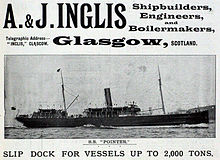A. & J. Inglis
The shipbuilding company A. & J. Inglis of Glasgow ran the Point House shipyard and engineering department Whitehall Engine Works. A. & J. Inglis existed from 1847 to 1963.
history
The first 50 years
The brothers Anthony and John Inglis founded their company in 1847 to do mechanical engineering. In 1862 they opened their first shipyard, Pointhouse Ship Yard. From the beginning, the shipyard built iron steam and sailing ships for British, German, American and other shipping companies. Anthony Inglis died in 1884, after which his son John Inglis took over his position. The build list in the 1880s consisted of 18 large tankers for the Standard Oil Company and twelve large liner cargo vessels for the British India Steam Navigation Company , followed by a number of smaller coastal vessels. In 1894 the shipyard exhibited its steamboat Taroba at the world exhibition in Antwerp .
Turn of the century until the war
In 1905 the company was converted into a limited company. At that time, the shipyard dealt mainly with the production of Clyde - steamers for the North British Railway . The year 1907 brought a climax when Inglis was chosen as the first civil shipyard to build the Royal Yacht, Alexandra for King Edward VII . In the following year, another yacht was built with the Vanadis . The 93 meter long steam yacht with schooner rigging was built to designs by Tams, Lemoine & Crane. In 1910 the Italian passenger steamer Tavolara with hull number 292 was launched. In the same year, the Buchanan Streamers shipping company ordered a very conservative paddle steamer Eagle III compared to other ships of the Victorian era . It reached a speed of 16.5 knots, but on its maiden voyage developed such a heel that one of the paddle wheels was lifted out of the water. The ship was returned to its builders at A. & J. Inglis, who completely rebuilt her hull and launched the ship for the second time in March 1911. From 1911 the British Admiralty ordered a number of destroyers and minesweepers from Inglis, which should lead to further orders in the coming war.
Two world wars
At the beginning of the war in 1914, the shipyard had 1,500 employees. During the war years, it mainly continued to produce Admiralty building contracts. In 1917 the Belfast shipyard Harland & Wolff took over the majority of the shares in Inglis, but left the shipyard as an independent company. After the end of the war, the company continued its construction program of passenger ferries , cable layers and coastal freighters, including special smooth-deck ships for South American accounts.
In the 1930s the shipyard ran into difficulties due to a lack of orders due to the global economic crisis . Against this background, the construction of the world's first direct-acting diesel-electric wheel “steamer” in 1935, the Talisman , is all the more remarkable.
During the Second World War, eleven corvettes, nine trawlers, a large number of standard coastal freighters and tankers and a Humber ferry were built. The Waverley was also created during this time; the paddle steamer with two chimneys is still in service today as a tourist attraction on the Clyde.
Post-war years and the end of the shipyard
After the end of the Second World War, Inglis built 14 whalers for Norwegian customers. The shipyard also built tugs, coasters, defensive boats and still some paddle steamers. A paddle steamer from this era that is still preserved today is the Maid of the Loch, built in 1953 .
The traditional shipyard closed its doors in 1963. The area was bought by the Glasgow Corporation, the shipyard demolished and the area continued to be used for trading purposes.
A selection of well-known ships from A. & J. Inglis
- Hull number 14: The Cawarra was an Australian passenger ship put into service in 1864 , which capsized and sank in a severe storm on July 12, 1866 in the port of Newcastle . Of the 62 people on board, only one survived. The sinking of the Cawarra is one of the worst shipping accidents in the history of New South Wales .
- Hull number 160: The Camorta was a passenger ship of the British shipping company British India Steam Navigation Company put into service in 1881 , which transported passengers, mail and cargo between various ports in British India . On May 6, 1902, the ship got into a cyclone in the Baragua Flats near the mouth of the Irrawaddy River and sank. All 739 people on board were killed.
- Hull number 280: The British royal yacht Alexandra was built in 1907 by A. & J. Inglis shipyard in Glasgow, Scotland and was launched in 1908.
- Hull number 292: The Italian passenger steamer Limbara was launched in May 1910 under the name Tavolara . It was renamed Terranova in 1910 and Limbara in 1928 . The ship was rebuilt during the Second World War and put into service on February 1, 1944 as the German hospital ship Innsbruck for 84 patients. The ship was on 9/10. Sunk by an air raid on the pier in Trieste in June 1944. The wreck was lifted, repaired and operated by the shipping company Tirrenia di Navigazione in Genoa in 1946 until it was scrapped in January 1964.
- Hull number 306: The Sir Harvey Adamson was a passenger ship of the British India Steam Navigation Company , which disappeared without a trace on the coast of Burma in 1947 with 269 people on board and has not yet been discovered.
Web links
- A. & J. Inglis at Grace's Guide (English)
Footnotes
- ↑ Bernard Dumpleton: The Story Of The Paddle Steamer, Intellect Books, 2002, ISBN 1-84150-801-2 , page 104th
- ↑ Shipping Times


